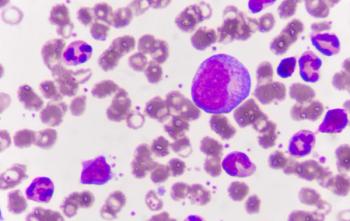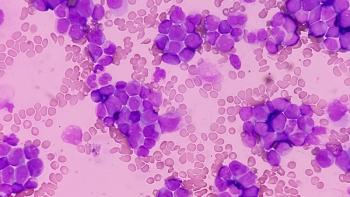
Suicide Risk and Lung Cancer: Are Clinicians Aware?
Researchers found that the rate of suicide in patients with lung cancer is much higher than those with other types of cancer.
Jeffrey Port, MD
The number of suicides in patients with cancer is nearly twice that of the general population. However, when compared with breast, prostate, and colorectal cancers (the 3 other most prevalent nonskin cancers), lung cancer—associated suicide rates are much higher, according to research presented at the recent 2017 ATS (American Thoracic Society) conference.
“We wanted to see what the impact of one of life’s most stressful events is on patients,” explained first author on the study, Mohamed Rahouma, MD, a postdoctoral cardiothoracic research fellow at Weill Cornell Medical College/New York Presbyterian Hospital. “I think it’s fair to say that most clinicians don’t think about suicide risk in cancer patients. This study, I hope, will change that by making us more aware of those at greatest risk of suicide so that this catastrophe in the care of our patients doesn’t happen.”
In an interview with Oncology Nursing News, Jeffrey L. Port, MD, senior author on the study, specializing in cardiothoracic surgery with Weill Cornell Medicine, added, “I think we as doctors do a good job with the physical examination and understanding the laboratories and imaging, but we don't necessarily do a thorough emotional or psychosocial evaluation.”
Using the Surveillance, Epidemiology, and End Results (SEER) database, researchers studied the suicide deaths in all cancers, as well as in specific types (lung, prostate, breast, and colorectal) over a period of 40 years (1973-2017). For each type, researchers also looked at the suicide trends over time and the time from cancer diagnosis to suicide for each type. To focus on lung cancer, the researchers also recorded demographic, social, and tumor-related factors, hoping to get a better idea of who would be at a high-risk.
Suicide Risk Among Patients With Cancer by the Numbers
Of the 3,640,229 patients with cancer studied, researchers found 6661 cancer-associated deaths by suicide, which were most notable among patients with lung cancer. Compared with the general population, patients with cancer had a 60% higher suicide rate. Patients with lung cancer had a 420% higher rate, colorectal cancer was 40% higher, and breast and prostate cancers were both 20% higher.
“There’s no doubt that lung cancer is a serious diagnosis,” Port said. “A patient gets a diagnosis, and then a treatment plan that’s pretty extensive, and it can include chemotherapy, radiation, and even surgery. There’s a lot to handle there. It’s often overwhelming, early on.”
This stress can be compounded when there are other medical conditions to consider. “Many of our patients have extensive comorbidities, the same group of patients that have heart disease from smoking, and many of them are older and more frail,” Port said.
Patients with lung cancer can also feel a lack of support due to the stigma associated with this disease. “This is considered a disease they brought upon themselves by smoking,” Port said. “There's not as much emotional support or sympathy perhaps, they feel, as other types of cancers.”
Data from the National Vital Statistics Reports, published by the CDC’s National Center for Health Statistics show that the general population has a suicide rate of 13/100,000 person-years. Researchers found that the cancer-associated suicide rate is more than double that, at 27.5/100,000 person-years, standardized mortality rate 1.6.
The standardized mortality rate, or SMR, compares the number of deaths in the study population to the number of deaths expected in the standard population. Patients with lung cancer had the highest SMR at 4.2―this population is also the only one to exceed the SMR for all cancer patients. Colorectal cancer and breast cancer both had a SMR of 1.4, while prostate cancer had an SMR of 1.2.
Lung cancer patients also showed the least amount of time between diagnosis and suicide―a median of 7 months. All other types proved far higher―for colorectal cancer the median was 37 months, breast cancer was 52 months, and prostate cancer was 56 months.
“What’s striking to me, regardless of the stage of the diagnosis, having lung cancer is portrayed with a terminal outcome,” Port commented. “If a patient starts asking about numbers and chances of cure, compared to breast and prostate for example, the results are not as favorable.”
However, there has been an overall trend toward a decrease in suicide over time, and this decrease has been more noticeable in patients with lung cancer. Port hopes this trend will continue, “as we talk about things like CAT scan screening, liquid biopsy, and potentially blood tests in the future,” to provide for better screening and earlier diagnosis. “There’s reason to be hopeful.”
Supporting Patients With Lung Cancer: What Clinicians Can Do
Importantly, the researchers determined the factors that could indicate a patient with lung cancer would be at high risk for suicide. They found that patients with lung cancer were more likely to die by suicide if they were male, Asian, widowed, older (70-75 years), refused surgical treatment or had a difficult-to-treat type of cancer (metastatic, small-cell lung carcinoma histology).
Identifying these high-risk patients is important as it can allow clinicians to provide psychological assessment, support, and counseling to reduce the rates of suicide. Port added, “We have to do a better job in assessing those emotional needs as well. If we can do that, and we can tease out the risk factors, then you can intervene earlier.” Port explained that intervention could as simpler as a referral to a social worker, psychologist, or psychiatrist.
“While cancer diagnosis counseling is an established practice, especially if a patient seems depressed, referral for ongoing psychological support and counseling typically does not happen,” Rahouma said. “This represents a lost opportunity to help patients with a devastating diagnosis.”
Port also commented on what an elevated rate of suicide, as seen in the population of cancer patients, implies. “It’s not just about suicide,” he noted. “If you have these higher suicide rates, it must also imply that there’s a higher distress level among all of our patients. That’s what’s important here.”
Newsletter
Knowledge is power. Don’t miss the most recent breakthroughs in cancer care.
















































































